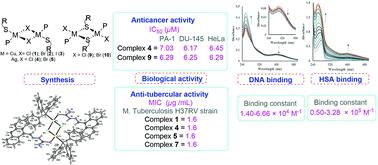当前位置:
X-MOL 学术
›
Dalton Trans.
›
论文详情
Our official English website, www.x-mol.net, welcomes your
feedback! (Note: you will need to create a separate account there.)
Copper(I) and silver(I) complexes of anthraldehyde thiosemicarbazone: synthesis, structure elucidation, in vitro anti-tuberculosis/cytotoxic activity and interactions with DNA/HSA
Dalton Transactions ( IF 3.5 ) Pub Date : 2020-10-20 , DOI: 10.1039/d0dt03104f Ashiq Khan 1 , Kamaldeep Paul , Iqubal Singh , Jerry P Jasinski , Victoria A Smolenski , Ethan P Hotchkiss , Patrick T Kelley , Zachary A Shalit , Manpreet Kaur , Somesh Banerjee , Partha Roy , Rekha Sharma
Dalton Transactions ( IF 3.5 ) Pub Date : 2020-10-20 , DOI: 10.1039/d0dt03104f Ashiq Khan 1 , Kamaldeep Paul , Iqubal Singh , Jerry P Jasinski , Victoria A Smolenski , Ethan P Hotchkiss , Patrick T Kelley , Zachary A Shalit , Manpreet Kaur , Somesh Banerjee , Partha Roy , Rekha Sharma
Affiliation

|
A reaction of copper(I) halides (X = I, Br, Cl) and silver(I) halides with 9-anthraldehyde thiosemicarbazone (9-Hanttsc, H1L) and triphenylphosphine produced halogen-bridged dinuclear complexes, [M2(μ2-X)2(η1-S-9-Hanttsc)2(Ph3P)2] (M = Cu, X = Cl, 1; Br, 2; I, 3; M = Ag, X = Cl, 4; Br, 5). A similar reaction of 9-anthraldehyde-N1-methyl thiosemicarbazone (9-Hanttsc-N1-Me, H2L) with Ph3P and silver(I) halides yielded sulfur-bridged dimers, [Ag2X2(μ2-S-9-Hanttsc-N1-Me)2(Ph3P)2] (X = Cl, 9; Br, 10), however with copper(I) halides insoluble compounds were formed, which upon the addition of one extra mole of Ph3P gave mononuclear complexes of the formula [CuX(η1-S-9-Hanttsc-N1-Me)(Ph3P)2] (X = Cl, 6; Br, 7; I, 8). All of the complexes have been characterized by elemental analysis, NMR (1H, 13C) spectroscopy and single crystal X-ray crystallography (2, 5, 6, and 9). Both the ligands (H1L and H2L) and their complexes (1–10) were tested for their anti-tubercular and anticancer activities. The interactions of the ligands and their complexes (copper and silver) with calf thymus DNA (ct-DNA) and human serum albumin (HSA) were examined through UV-visible and fluorescence spectroscopy. Results showed that copper complex 2 displayed strong interactions with ct-DNA and HSA having binding constant values of 6.66 × 104 M−1 and 3.28 × 104 M−1, respectively, followed by silver complex 10 which gave binding constant values of 4.60 × 104 M−1 and 3.06 × 104 M−1, respectively. All of the complexes also showed good interactions with DNA in docking studies.
中文翻译:

蒽醛缩氨基硫脲的铜 (I) 和银 (I) 配合物:合成、结构解析、体外抗结核/细胞毒活性以及与 DNA/HSA 的相互作用
铜 ( I ) 卤化物 (X = I, Br, Cl) 和银 ( I ) 卤化物与 9-蒽醛缩氨基硫脲 (9-Hanttsc, H 1 L ) 和三苯基膦反应生成卤素桥连双核配合物 [M 2 ( μ 2 -X) 2 (η 1 -S-9-Hanttsc) 2 (Ph 3 P) 2 ] (M = Cu, X = Cl, 1 ; Br, 2 ; I, 3 ; M = Ag, X = Cl , 4 ; Br, 5 )。9-蒽醛-N 1-甲基缩氨基硫脲 (9-Hanttsc- N1 -Me, H 2 L ) 与 Ph 3 P 和卤化银 ( I ) 产生硫桥二聚体,[Ag 2 X 2 (μ 2 -S-9-Hanttsc- N 1 -Me) 2 (Ph 3 P) 2 ] (X = Cl, 9 ; Br, 10 ),然而与铜 ( I ) 卤化物一起形成不溶性化合物,在加入一摩尔 Ph 3 P 后得到式 [CuX(η 1 - S-9-Hanttsc- N 1 -Me)(Ph 3 P) 2] (X = Cl, 6 ; Br, 7 ; I, 8 )。所有的复合物已通过元素分析,NMR(1 H,13 C)光谱和单晶X射线晶体学(2,5,6,和9)。配体(H 1 L和H 2 L)及其配合物(1–10) 测试了它们的抗结核和抗癌活性。配体及其配合物(铜和银)与小牛胸腺 DNA (ct-DNA) 和人血清白蛋白 (HSA) 的相互作用通过紫外-可见光和荧光光谱进行了检查。结果表明,铜配合物2显示出与 ct-DNA 和 HSA 的强相互作用,其结合常数值分别为 6.66 × 10 4 M -1和 3.28 × 10 4 M -1,其次是银配合物10,其结合常数值为 4.60 × 10 4 M -1和 3.06 × 10 4 M -1, 分别。在对接研究中,所有复合物也显示出与 DNA 的良好相互作用。
更新日期:2020-11-19
中文翻译:

蒽醛缩氨基硫脲的铜 (I) 和银 (I) 配合物:合成、结构解析、体外抗结核/细胞毒活性以及与 DNA/HSA 的相互作用
铜 ( I ) 卤化物 (X = I, Br, Cl) 和银 ( I ) 卤化物与 9-蒽醛缩氨基硫脲 (9-Hanttsc, H 1 L ) 和三苯基膦反应生成卤素桥连双核配合物 [M 2 ( μ 2 -X) 2 (η 1 -S-9-Hanttsc) 2 (Ph 3 P) 2 ] (M = Cu, X = Cl, 1 ; Br, 2 ; I, 3 ; M = Ag, X = Cl , 4 ; Br, 5 )。9-蒽醛-N 1-甲基缩氨基硫脲 (9-Hanttsc- N1 -Me, H 2 L ) 与 Ph 3 P 和卤化银 ( I ) 产生硫桥二聚体,[Ag 2 X 2 (μ 2 -S-9-Hanttsc- N 1 -Me) 2 (Ph 3 P) 2 ] (X = Cl, 9 ; Br, 10 ),然而与铜 ( I ) 卤化物一起形成不溶性化合物,在加入一摩尔 Ph 3 P 后得到式 [CuX(η 1 - S-9-Hanttsc- N 1 -Me)(Ph 3 P) 2] (X = Cl, 6 ; Br, 7 ; I, 8 )。所有的复合物已通过元素分析,NMR(1 H,13 C)光谱和单晶X射线晶体学(2,5,6,和9)。配体(H 1 L和H 2 L)及其配合物(1–10) 测试了它们的抗结核和抗癌活性。配体及其配合物(铜和银)与小牛胸腺 DNA (ct-DNA) 和人血清白蛋白 (HSA) 的相互作用通过紫外-可见光和荧光光谱进行了检查。结果表明,铜配合物2显示出与 ct-DNA 和 HSA 的强相互作用,其结合常数值分别为 6.66 × 10 4 M -1和 3.28 × 10 4 M -1,其次是银配合物10,其结合常数值为 4.60 × 10 4 M -1和 3.06 × 10 4 M -1, 分别。在对接研究中,所有复合物也显示出与 DNA 的良好相互作用。











































 京公网安备 11010802027423号
京公网安备 11010802027423号